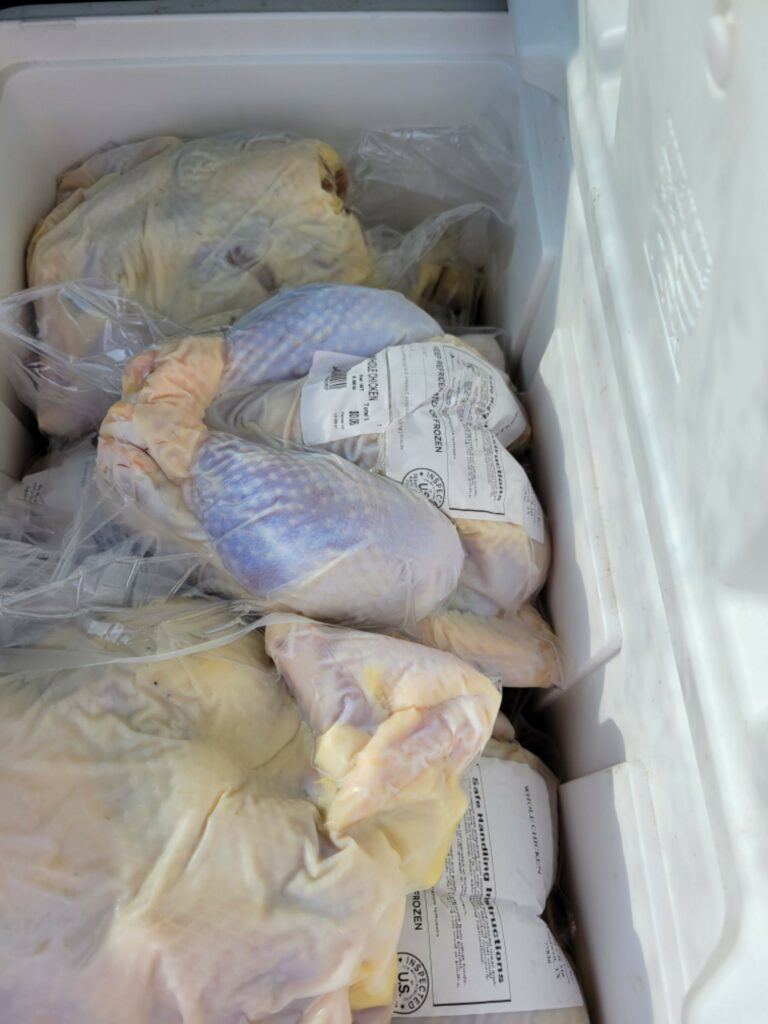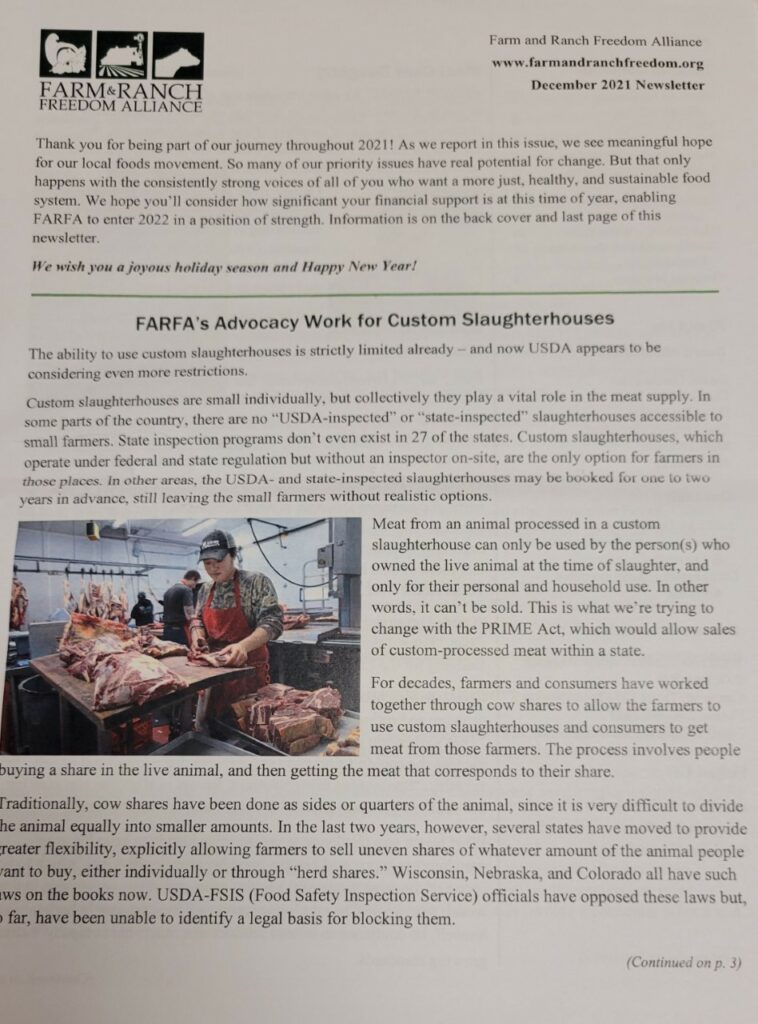Agricultual Economist and Farmer Michael Smith, Sherman Act, Part 2: The Small Farmer Pitchfork Army Most are now aware of the Biden Administrations recent announcement and press briefing for a plan to combat prices in the meat industry. If not, you can find a bit of information here: Readout of President Joe Biden’s Event with Farmers, “Ranchers on his Action Plan for a More Competitive Meat and Poultry Supply Chain“ And you can also see one rebuttal from the Big Four processors: “New Biden plan aims to expand meat processing, lower consumer prices” (desmoinesregister.com) I have to push back on some of the claims made by their spokesperson, mostly their supposed labor shortage, and yet they have very high H-1A visa activity to obtain
Topics:
run75441 considers the following as important: agricultural economics, Cattle, Featured Stories, Hot Topics, Michael Smith, Pigs, politics, US EConomics
This could be interesting, too:
Robert Skidelsky writes Lord Skidelsky to ask His Majesty’s Government what is their policy with regard to the Ukraine war following the new policy of the government of the United States of America.
NewDealdemocrat writes JOLTS revisions from Yesterday’s Report
Joel Eissenberg writes No Invading Allies Act
Ken Melvin writes A Developed Taste
Agricultual Economist and Farmer Michael Smith, Sherman Act, Part 2: The Small Farmer Pitchfork Army
Most are now aware of the Biden Administrations recent announcement and press briefing for a plan to combat prices in the meat industry. If not, you can find a bit of information here:
Readout of President Joe Biden’s Event with Farmers, “Ranchers on his Action Plan for a More Competitive Meat and Poultry Supply Chain“
And you can also see one rebuttal from the Big Four processors:
“New Biden plan aims to expand meat processing, lower consumer prices” (desmoinesregister.com)
I have to push back on some of the claims made by their spokesperson, mostly their supposed labor shortage, and yet they have very high H-1A visa activity to obtain workers, but that is a whole other article and deep dive in and of itself.
In Part 1, Sherman Act v. Modern Conglomerate Agriculture, we defined the difference between a producer and a processor. Essentially, a producer is a farmer or rancher. A processor, by many other names is a butcher, slaughterhouse, or abattoir for you martini drinkers. But what constitutes a processor?
There are four currently levels of meat processing, with varying levels of what is allowed and what isn’t.
Let’s start with the simplest
Field dressing – most deer hunters understand this one and learn to avoid it. You hunt or slaughter your own animal, skin, clean, part, and eat what you have hunted and rendered. This is usually done as a licensed hunter and as long as you follow the game laws and consume what you have grown or hunted, there are usually no further complexities. Any of this meat can not be sold and if given to folks can leave you liable should someone not properly prepare.
Custom Slaughterhouses – these are only available in 23 states, are loosely regulated, not inspected local establishments that will process almost any animal that you have farmed or hunted, but only for direct consumption by the farmer or hunter, same rules apply as Field Dressing, the only difference is they do the dirty work for you. The Farm and Ranch Freedom Alliance is currently petitioning states to outlaw these facilities and force them to be inspected, for better or worse, and these guys are the target of this article as well. We continue.
Cottage Laws – this has been getting a lot of attention lately due to farmers markets and local farms selling produce, eggs, dairy and limited meats to the general public. I can sell produce no strings attached. I can sell eggs and processed foods with proper labels. I can sell 999 field dressed or customed chickens or 300 rabbits each year under these laws.
The 1,000th chicken will get me a visit from the USDA, who will require me to have chickens 1,000-99,999 processed at a USDA inspected facility, or b) spend the $35,000+ on licensing, equipment, and a facility. I can sell up to 999 chickens either from my farm store on site, or satellite store from my tent at the farmers markets, with a catch. Sunday, I drove out to Jim’s dairy barn to go get some raw milk. He can sell me milk, along with the general public from his farm where the cows are screaming to be milked. The cheese I make from the milk, I can’t sell. Resale is not easy and sometimes illegal.
USDA Inspected Facility – the USDA dictates, by federal legal authority, the how and by whom can process for public consumption any items that are of a volatile nature: dairy and meats. These can be large multi-national, publicly traded companies such as the Big Four, or they can be small operators. These establishments are highly regulated, and are prohibitively expensive to set up. Anything coming out of a USDA inspected facility can be sold or resold almost anywhere.
In 2011 the USDA conducted a study that showed a growing trend. Here is the gist of it, “[ . . . ] slaughterhouses have experienced a net decrease from 1990 to 2010, falling nationwide from over 1,200 in the early 1990s to approximately 800 by 2010.”
That is more than a third reduction of USDA inspected facilities for livestock processing and has only gotten worse as the Big Four now control 85% of the total market. Most federally regulated facilities are large contract processors like Cargill and Tyson, middle market beef ranches who process and have contracts with restaurants, or are secondary outlets such as sausage makers. In other words, a large majority of these facilities are not open to the majority of farmers and ranchers.
As processors have driven down cattle prices at the farm gate, and driven up margins to retailers, farmers and ranchers are starting to take notice. Rather than allow the Big Four to push many out of business, we have collectively grabbed our pitchforks, grabbed the Federal governments ear and are getting after it.
We don’t need to Sherman Act for the big guys. Allow the Pitchfork Brigade to do its thing.
.
Yes, that is pasture raised chicken with a USDA inspected label. And we are not alone. Farms in our area have pork and beef, a farm in the next county over 5,000 chickens a year. How? We go direct. We also have a small CSA (community supported agriculture) where you buy stock in the farms’ goods. Stockholders in food! Here is a largely incomplete list by state, but google a local farm and I can almost guarantee they have a CSA. “We’re Compiling a List of CSAs in All 50 States” – Modern Farmer
It is hard to find charts and data on how many farms have been started since the pandemic has hit. They are all largely independent with a very high failure rate. With an uptick in farms and also established producers looking to independent processors for their animals, this has become another chokepoint in the process. The local butchers are inundated. We all talk about delivery dates in the months, if not quarters in the future.
The Sherman Act could be used to break up the big producers into smaller regional ones, but this would hurt our local small businesses. Or, would only preserve the status quo. Regional big boys would prefer to deal with contracts for one or two large regional producers, not 500 of us just showing up from time to time. They have shareholders to please and earnings reports due.
A New Way
Fred (not his real name) and family have been farming chickens for more than 20 years on a relatively small plot of land, around 20 acres or so (as opposed to the current average of 440 acres per farm) about an hour outside of Austin. We’ve known them indirectly for only a little while but recently, well, Fred processes my chickens, above, at his USDA inspected facility, right next to his chicken coops. How they got there is a grueling grind of 20+ years of working toward a goal, some luck, and a few restaurant owners in Austin who saw and tasted the difference in pastured poultry that is minimally processed, healthy, flavorful. It’s an odd story that involves a Netflix TV show personality, a famous chef and famous podcast.
Fred and family grew their chicken farm and started marketing. Over time around 2010, an Austin chef, Gerry (not his real name), took notice and started buying their chicken for his farm to table restaurant in Austin, TX.
Gerry is a native Texan who believes heavily in what we are doing; farm to table and local at that. He tries to source as much as he can within a few hours drive. Needless to say, the push for local over the past three years has been great, restaurants in every major city are seeing the benefits.
The catch, at the time was that Fred had to dump considerable amounts of cash and energy to acquire commercial processing equipment, a facility to house it and also for the USDA to inspect not only the machinery and facility but Fred and his family themselves. I could do things myself, but I leave it to Fred to process. That medallion on each bird is a burden we both pay for, but also is a great form of insurance. And I get to sell to anyone. It is pricy, adding $4-5 more per bird, but unlocks new markets as well as protections.
If the Biden Administration is reading (I am not holding my breath but it’s an interesting supposition), a $1 billion structured program could be done in a two- tiered system focused on the established facilities like Fred’s and also the future, those who are just getting started.
Tier one could be established so that processors who have annual revenues below $250,000 are granted a $50,000 immediately available cash infusion to expand operations. The biggest limiting factor for any processor is freezer space, or cold chill areas.
Tier two could be those who would like to start and could be granted a $25,000 loan for equipment and licensing, and a goal point established for an additional $25,000 in grants once they hit a certain mark. The loan is to incentivize and have skin in the game.
We could also offer a ladder to custom processors to help get them up to USDA certified and inspected. The Farm & Ranch Freedom Alliance, December 2021 Newsletter highlights some of the differences among other highlights:
All in, this would be a huge step forward and still leave another $900 million on the table (assuming we have 1,000 current small processors, and an additional 1,000 wanting to get into the business) for things like cold storage for local producers, lockers and refrigerated trucks akin to what The Common Market is doing. They set up regional distribution hubs for farmers like me to take my produce to a facility they operate out here. My cabbage gets included with my neighbor’s celery to be distributed to Houston ISD schools to feed kids. They pay us a fair price to do so or would do so if they had the funding to plug us all into every school district in the country.
Fred and others who currently have a large financial barrier to entry are also out here and could process pastured poultry for school meals, and also provide pork, and beef. We could plug into food banks and donate our bumpers and volunteer crops or plug into SNAP to provide weekly CSA boxes and pantry Staples delivered to people’s homes. We could make substantial headway in agricultural communities to connect to communities struggling with food access.


